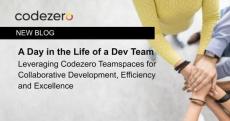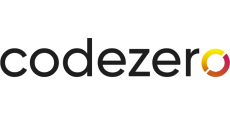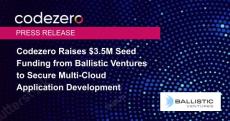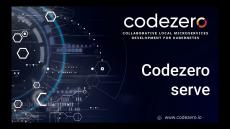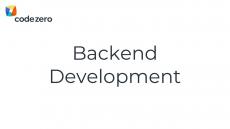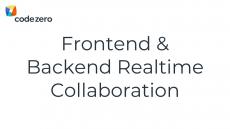|
By Narayan Sainaney
Developing microservices destined to run in Kubernetes presents a unique set of challenges. In this blog post, we’ll explore a new approach leveraging Codezero in order to enhance both productivity and security.
|
By John Poyser
As software projects become more complex and the need for speed increases, catching critical bugs and vulnerabilities early in the process is crucial. This is where Codezero steps in, reshaping the DevOps cycle by focusing on “Shift Left” and early bug detection.
|
By John Poyser
Dev Teams rely on their Dev Leaders and DevOps to fill a crucial role, bridging the gap between development and operations to ensure smooth workflows in the fast-paced world of software development. This role requires not only technical expertise but also the ability to navigate team dynamics and project management challenges. Enter Codezero Teamspaces, a tool essential for modern Dev Teams fostering collaborative development.
|
By Mark Allen
Leveraging Codezero can significantly benefit AI developers in building better, larger, and more sophisticated models through its suite of features designed to simplify and secure microservices development. By addressing common challenges in AI model development, such as environment consistency, collaboration, scalability, and security, Codezero provides a conducive environment for innovation and efficiency. Here’s how AI developers can harness Codezero for these advantages.
Vancouver – March 12, 2024 – Codezero, the innovator in secure enterprise microservices development, today announced a $3.5 million seed-funding round led by Ballistic Ventures, the venture capital firm dedicated exclusively to funding entrepreneurs and innovations in cybersecurity. This investment marks a significant leap forward in Codezero’s mission to reimagine multi-cloud, collaborative microservices development.
|
By Kris Bondi
The challenge with security around the development process is that too often it has felt like it was bolted on after the fact, because it was. It’s no wonder that an announcement that a new security tool has been added to the process is likely to elicit a collective eye roll from a development team. To be clear, developers are not against security, but they are skeptical of new processes and tools being added by security teams with no development experience.
|
By Narayan Sainaney
Ephemeral Environments are disposable pre-production environments that are used by various members of the development team to test software under specific conditions. Ephemeral environments are an essential part of a modern DevOps process and integral to the development and efficient release of resilient software.
|
By Narayan Sainaney
A lot is written about best practices around DevOps and the following guide will highlight some practices that will further enhance your development team’s productivity and happiness.
|
By Reed Clayton
With many options to modernize tech stacks and improve developer UX, it’s hard to know where to start. Consider starting with your Software Development Life Cycle. There are a number of opportunities that can provide quick wins for a development team without disrupting productivity and release cycles while saving money and improving developer experience and deployment times.
|
By CodeZero
CodeZero announces the general availability of Surf, a developer tool that provides real-time, collaborative, rich-querying capability for pre-production Kubernetes environments. Surf allows developers and teams to de-mystify Kubernetes artifacts, provides powerful troubleshooting capabilities and improves collaboration.
|
By CodeZero
Details the functionality and usage of Codezero Teamspaces' Consume function. With Consume, you're able to see and access Kubernetes cluster based services as if they were local on your laptop with no performance degradation or resource constraints. You have to see it to believe it.
|
By CodeZero
Using Codezero Teamspaces' Serve feature enables Devs to harmonize their local with production environments using advanced traffic routing to seamlessly create and publish new services and variants back to the cluster seamlessly from their local workspace. Your Devs will be more productive, focused and happy using the tools they know and love without having to focus on infrastructure or cloud environment.
|
By CodeZero
Join AJ as he demonstrates using CodeZero's Desktop app to accelerate and assist with backend development.
|
By CodeZero
Join Narayan as he walks through a frontend developer workflow using Teleport.
|
By CodeZero
Join Grant as he walks through a backend developer workflow using Intercept and Teleport.
|
By CodeZero
Join Narayan as he goes over creating Development Profiles in CodeZero as part of a collaboration workflow.
|
By CodeZero
Join AJ and Grant as they demonstrate real-time collaboration between a frontend and backend developer using CodeZero.
- April 2024 (5)
- March 2024 (3)
- December 2023 (2)
- April 2023 (1)
- July 2022 (1)
- June 2022 (1)
- May 2022 (6)
- April 2022 (1)
- January 2022 (1)
- October 2021 (4)
- September 2021 (4)
CodeZero makes it easy for developers to develop seamlessly and deploy fearlessly to production in your cloud provider of choice.
Through optimizing development cycles and reducing reliance on Kubernetes experts, CodeZero increases Engineering Team velocity across the Development, Deployment and Operation of their code.
Tools for local collaborative development in pre-production Kubernetes clusters:
- Teleport: Route local requests to remote services. Test local code that relies on services running in-cluster.
- Intercept: Route remote requests to local services. Collaborate with other developers to test changes in real-time.
- Mount: Use workload volumes locally. Read/write to remote volumes as if you are in the cluster.
- Desktop App: Install the CodeZero Desktop app and run commands from your system tray, then view your running sessions in a visual dashboard.
Move traffic, not containers.




